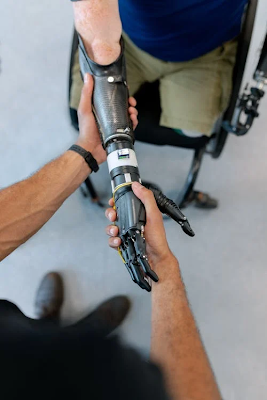410

Loss of sensation is a major problem for people who don’t have an upper limb. This prevents them from using the full functionality of their prosthetic hands. Although modern artificial hands are capable of controlling all 5 fingers mechanically, users can control one grasping movement at a time.
Researchers at Florida Atlantic University of Engineering (FAU) investigated whether people could control grip forces applied simultaneously to two different objects held in artificial hands. To do so, they developed a novel wearable robotic armband which can transport touch sensations to the arms of users. They also studied the role of visual and haptic (touch) sensations in grasping.
Haptic feedback is a technology that can create a sense of touch by applying vibrations, forces to the user. Using haptic feedback, users could complete activity without dropping or breaking objects even as their vision was blocked. This approach of transporting objects also saved time for users which was not the same with conventional prosthetic hands. Users were able to do this activity as their brain was able to convert the haptic sensations into movements.
“Our study is the first to demonstrate the feasibility of this complex simultaneous control task while integrating multiple channels of haptic feedback noninvasively,” said Erek Engeberg, corresponding author and professor at FAU. “None of our study participants had significant prior use of EMG-controlled artificial hands. Yet they were able to learn to harness this multitasking functionality after two short training sessions.”
To create haptic feedback, Engeberg and his team worked on EMG control and the design of the armband. EMG or electromyography is a diagnostic procedure to assess the working of muscles.
The novel armband designed by the team had soft actuators that can sense contact forces. Vibrotactile stimulators were added to identify broken objects when grasped. The armband was designed for haptic feedback at three different positions. These were thumb, index and little finger. All three can be evaluated based on the intensity of force applied to the object.
The armband had three air chambers, each of which responded to the fingertips. The three vibrotactile actuators were co-located. They would vibrate or alert the user if the grasped object had broken or the force had increased.
“Examples of multifunction control demonstrated in our study included the proportional control of a card being pinched between the index and middle fingers at the same time that the thumb and little finger were used to unscrew the lid of a water bottle. Another simultaneous control demonstration was with a ball that was grasped with three fingers while the little finger was simultaneously used to toggle a light switch,” said Moaed A.Abd, first co-author of the study and PhD student at FAU.
The information extracted through the study could be used in future to carry out complex bimanual operations. For instance, required for guitarists and surgeons, to enable upper-limb absent people or prosthetic hand users to pursue their dreams.
“Enabling refined dexterous control is a highly complex problem to solve and continues to be an active area of research because it necessitates not only the interpretation of human grasp control intentions. But also complementary haptic feedback of tactile sensations,” said Stella Batalama, PhD and FAU dean. “With this innovative study, our researchers are addressing the loss of tactile sensations, which is currently a major roadblock in preventing upper limb-absent people from multitasking or using the full dexterity of their prosthetic hands.”
The detailed study has been published in the journal Scientific Reports.
Contributed by: Simran Dolwani
To ‘science-up’ your social media feed, follow us on Facebook, Twitter or Instagram!

